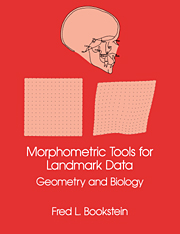6 - Principal axes of shape change for triangles
Published online by Cambridge University Press: 23 November 2009
Summary
The preceding chapter set forth statistical machinery for unambiguously detecting effects upon shape–group difference, size allometry, covariances with exogenous variables. We showed how a space of shape variables apparently based on an arbitrary choice of triangles and baselines supported multivariate statistical analyses independent of those choices and equivalent to the study of all ratios of size variables as the latter were defined in Chapter 4. But the analysis so far has been carried out in purely statistical language, unrelated to biology and related only weakly even to the geometry that drives this practice. The coefficients in which findings are embodied remain functions of the baseline (or baselines) chosen for shape coordinates even as the statistical testing of those findings is invariant against changes of basis (Section 5.2.3).
This chapter and the next introduce methods for describing shape change in a manner having this same invariance against changes in choices of triangles and shape coordinates. This chapter concentrates on the simplest context of landmark morphometrics, the case of a single triangle. We shall be introducing the reporting of shape change by symmetric tensors, a report having precisely the requisite independence. We shall emphasize routines by which hints of underlying biological process may be gleaned from its geometry in diverse typical cases. The use of the symmetric tensor as a universal preliminary report of change in a single noncollinear triangle is the most important geometric formalism in morphometries. I shall derive it in two independent languages, the “algebraic version” and the “geometric version,” in the hope that the reader will be enlightened first by one or the other derivation and then by their interplay.
- Type
- Chapter
- Information
- Morphometric Tools for Landmark DataGeometry and Biology, pp. 187 - 255Publisher: Cambridge University PressPrint publication year: 1992



